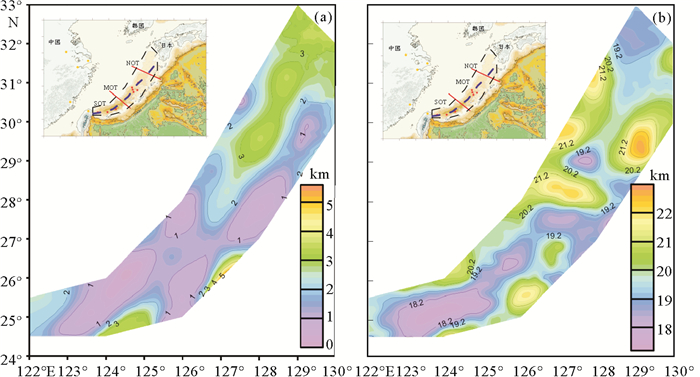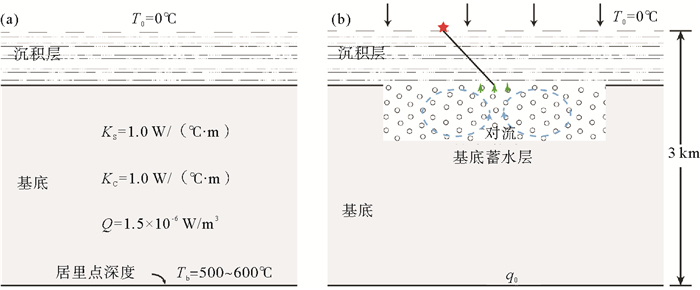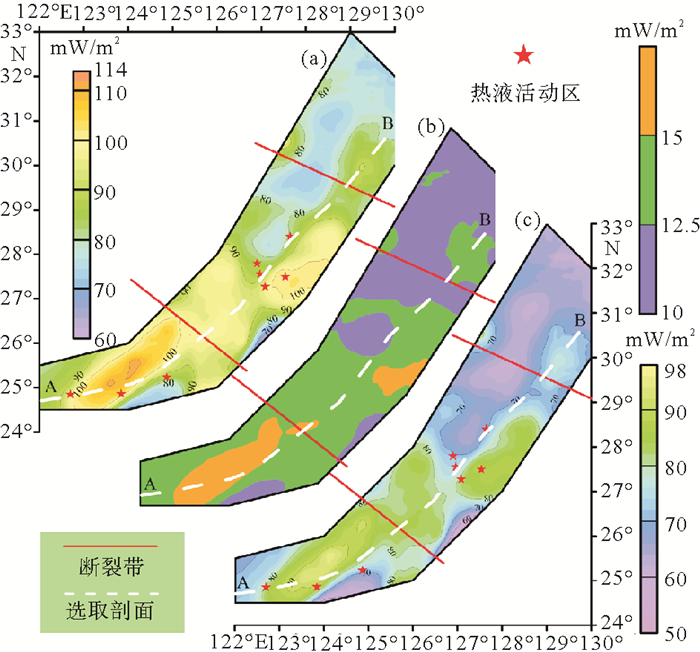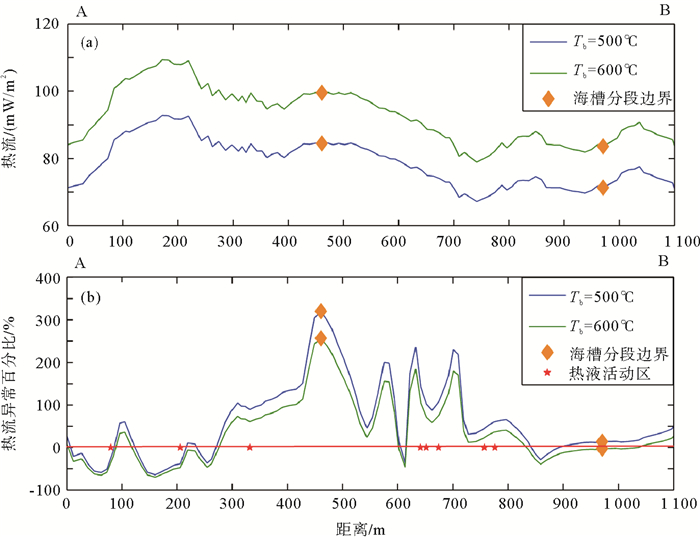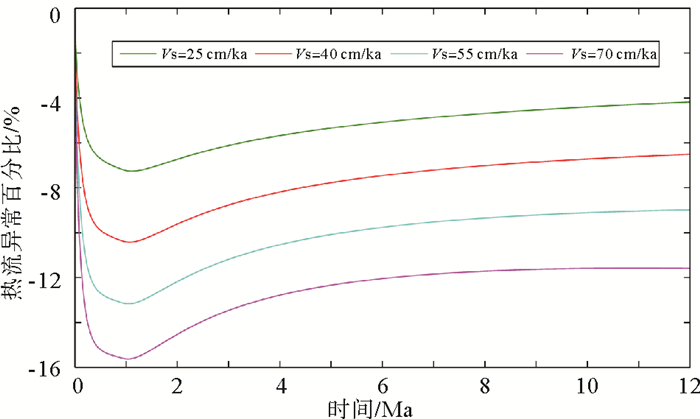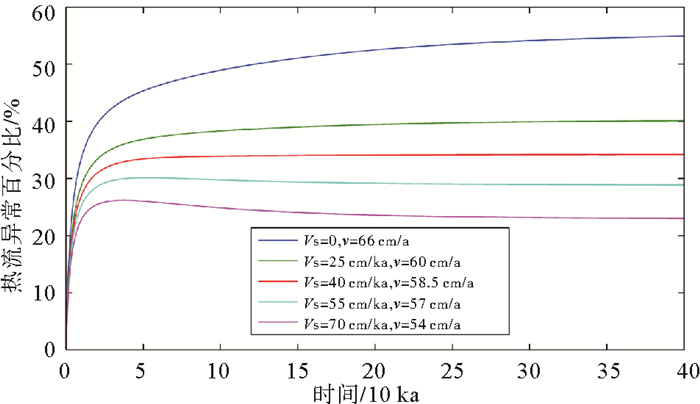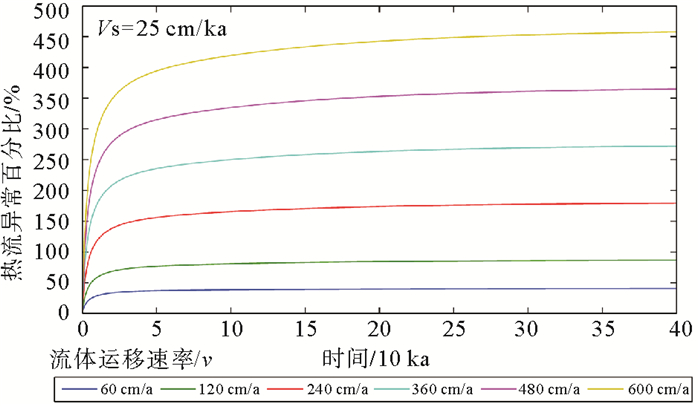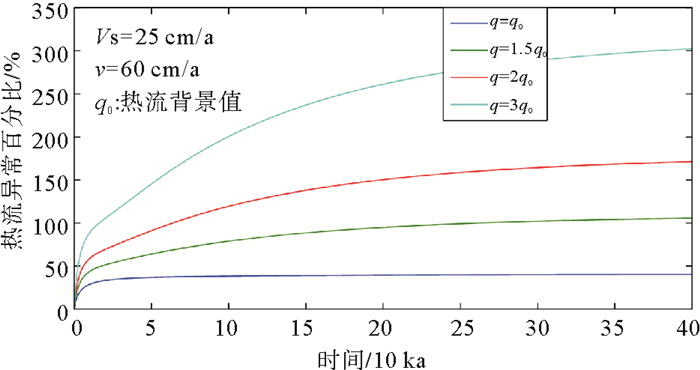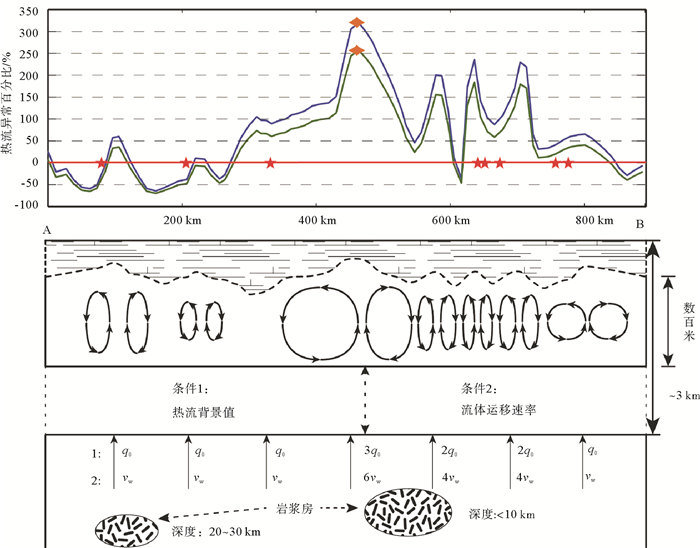INFLUENCES OF SEDIMENTATION RATE AND FLUID ACTIVITIES IN BASEMENT AQUIFERS ON SEAFLOOR HEAT FLOW IN OKINAWA TROUGH
-
摘要: 冲绳海槽海底热流值高且离散性强、热液活动发育,这一地热特征主要表现在海槽南段与中段,其形成与沉积过程和浅层基底水热活动密切相关。首先依据居里点深度资料计算海底热流背景值,并与实测热流资料进行对比,分析了冲绳海槽的海底热流异常特征。然后选取一条与海槽扩张中心走向一致的模拟剖面,以实测地热资料为约束,利用热模拟的方法,探讨了沉积速率和基底流体活动对海底热流值的影响。最后,探讨了海槽热流特征形成机制。热模拟结果表明,如果南段与中、北段分别在中中新世和晚更新世开始拉张,在冲绳海槽的形成演化过程中,沉积速率可使海槽南段和中段的海底热流值分别降低7%~16%和4%~12%,沉积速率越大对热流值的影响也越大;在基底流体活动的影响下,海槽热流值表现出极大的离散性,下降流体使得海底热流值进一步降低,上升流体作用则相反,海槽中段的上升流体影响远远超过沉积速率影响,使得局部海底热流值提高到背景值的3倍。在局部上升流体与下降流体运移速率相同的前提下,当沉积速率 < 25 cm/ka、流体运移速率为60~66 cm/a时最符合海槽南段西部的热异常形成条件;当宫古断裂及海槽中段基底蓄水层内的流体运移速率约为南段流体运移速率的4~6倍,或者蓄水层之下热流背景值约为南段背景值的2~3倍时,最符合宫古断裂带附近和海槽中段的热流异常形成条件,这可能预示着在 < 10 km深度处存在岩浆房。Abstract: The Okinawa Trough has high but variable mean heat flow values and extensive hydrothermal activities are developed there, especially in the south and north segments of the trough. These geothermal characteristics are closely related to the past and present sedimentation process and fluid activities in the shallow basement aquifers. This paper firstly calculated the background seafloor heat flow values on the basis of Curie Point Depth data, and compared them with the measured data to analyze the features of heat flow anomalies in the Okinawa Trough. Then, we selected a modeling profile along the spreading center and used the thermal modeling method to explore the influences of sedimentation rate and basement fluid activity on the seafloor heat flow. At last, we analyzed and discussed the possible genetic mechanisms of geothermal features. Modeling results indicate that, if extensional processes start at the middle Miocene for the South Okinawa Trough (SOT) and at the late Pleistocene for the Middle Okinawa Trough (MOT) and the North Okinawa Trough (NOT), the present seafloor heat flow would be reduced by 7%~16% for SOT and 4%~12% for MOT with the influence of sediment process; the larger the sedimentation rate is, the greater the effect will be produced. Fluid activities in the basement aquifers brought about the significantly scattered heat flow values, which were reduced above the upward flow and increased above the downward flow. With more influence of upward flow than that of sediment process, some values were increased up to 3 times of background values. On the premise of an equal fluid migration rate for upward flow and downward flow, a sedimentation rate of 25 cm/a and a fluid migration rate of 60~66 cm/a qualify the formation condition of geothermal anomalies in the western SOT. While for the formation of geothermal features nearby Gonggu fracture zone and in the MOT, it requires a migration rate of about 4~6 times or a heat supply (below basement aquifers) of about 2~3 times relative to that of SOT. The latter implies the existence of a magma chamber shallower than 10 km.
-
冲绳海槽地处俯冲弧后环境,构造地质活动强烈,海底热流特征复杂。研究冲绳海槽的地热特征及形成机制对深入了解西太平洋边缘海盆地的热演化[1]及热液活动形成的流体循环机制[2]具有重要意义。实测海底调查资料表明,冲绳海槽海底热流总体水平高且离散性强[3, 4]。南段热流平均值低于全球陆地热流平均水平(约65 mW/m2)[5],中段热流均值比全球平均水平高得多,局部地区海底热流值变化剧烈[6]。这种复杂的海底热流特征是在海槽拉张过程中发生的强烈构造地质活动基础上形成的,与沉积过程[2]及基底流体活动[3]等浅部环境因素密切相关[7-10]。受欧亚板块与菲律宾海板块碰撞作用影响,海槽内裂隙发育,这不仅为基底流体突破沉积层溢出地表形成热液活动提供了触发条件及通道,也为流体的贮存与横向运移提供了空间。
海底沉积物比基底层的传热效率低,当孔隙度为60%~80%时,其热导率在0.8~1.2 W/(m·℃)之间[11],因此,在地表热量散失过程中起着保温层的作用,抑制了海底热流散失效率,迅速沉积过程会使海底热流值大幅降低[2, 12, 13]。沉积层之下基底蓄水层内的流体活动加速了其与围岩之间的热量交换[14]。槽底大部分被沉积层覆盖,沉积层阻断了蓄水层流体同海水之间物质与能量的直接交换,但在局部基底裸露区域,可能会有冷的海水向下渗入形成“下降流”,也可能会有“上升流”由蓄水层向上运移并通过基底裸露部位溢出海底形成热液活动。“下降流”随着深度增加会不断吸收周围介质的热量,围岩因热减少而在地表表现为海底热流降低;相反,“上升流”则会随着深度减小不断向围岩释放热量,围岩因热量增加而在地表表现为海底热流升高。
铁磁性物质当温度超过居里点临界温度后会失去磁性,降低到居里点温度以下又会恢复磁性,因而居里点深度是一个很好的温度约束界面,其对应温度大约为580 ℃[15]。一般地,以岩石圈底界温度为约束计算某一特定地区的稳态热结构,然而岩石圈厚度及其底界温度(1 200~1 330 ℃)难以用现有的探测技术准确获得;另外,受软流层地幔活动(地幔对流、底辟、拆沉等)影响,岩石圈底部的热结构处于非稳态,居里点深度以上所受影响相对较小。因此,以居里点深度处的温度为约束比通常以岩石圈底界为约束能够更好地描述浅部稳态热结构,得到的浅部热流背景值也相对更加准确,热流背景值的准确与否直接制约着对海底热异常分析的准确程度。
1. 地质-地球物理特征
冲绳海槽是东亚大陆边缘SW—NE向展布的狭长槽状盆地,北浅南深,其西南端与北东端分别与台湾岛和日本岛相连,西滨宽阔平坦的东海大陆架,东邻琉球岛弧。海槽莫霍面深约16~24 km[16, 17],属于陆壳或过渡壳性质,南段拉张中心处地壳厚度只有14 km[18],疑似洋壳性质。依据该区构造地质特征,人们一般以宫古断裂带和吐噶喇断裂带为界将冲绳海槽分为南(SOT)、中(MOT)、北(NOT)三段(图 1)。冲绳海槽由中新世以来菲律宾海板块向欧亚板块俯冲造成的琉球弧后扩张形成,目前,人们对冲绳海槽[19-22]是否经历了多幕次分段拉张,南段、中段及北段拉张启动先后顺序及其形成的板块动力背景等问题还存在争议。
![]() 图 1 研究区位置虚线框为研究区边界,该区处于菲律宾海板块向欧亚板块俯冲形成的弧后环境,构造、地热特征复杂,热液活动发育Figure 1. Location of study areaThe dashed box indicates the boundary of the study area, which is located in a back-arc environment, related to the subduction process of the Philippine Sea Plate beneath the Eurasian Plate, with complex tectonic and geothermal characteristics and extensive hydrothermal activity
图 1 研究区位置虚线框为研究区边界,该区处于菲律宾海板块向欧亚板块俯冲形成的弧后环境,构造、地热特征复杂,热液活动发育Figure 1. Location of study areaThe dashed box indicates the boundary of the study area, which is located in a back-arc environment, related to the subduction process of the Philippine Sea Plate beneath the Eurasian Plate, with complex tectonic and geothermal characteristics and extensive hydrothermal activity我们在中国东部海区共收集到463个海底热流数据[2-4, 13, 23-29],其中位于冲绳海槽的有200多个,主要分布于扩张轴部。就各段而言,海槽内的实测热流数据主要分布于南段(94个)与中段(160个),北部数据较少。SOT最西南端热流值极低,具有一定离散性;SOT中部和MOT中部热流值很高且离散性非常强,热液活动发育。宫古断裂带附近热流值极高,说明这一断裂带在一定程度上控制了周边的海底热流分布,多余热量可能由断层摩擦生热作用产生,也可能与断裂切穿岩石圈底部导致岩浆或热液沿裂隙上涌等过程有关,短波长、高强度线性磁异常的存在说明在冲绳海槽之下有线状岩浆充填作用发生[30]。部分地区热流变化剧烈,如在伊是名海穴附近4 km范围内,热流可高达10 W/m2、低至10 mW/m2, 在海槽中段的Jade热液活动区,水平距离1 km范围之内热流可高达1 W/m2、低至0.1 W/m2[6],这种剧烈变化可能由热液循环过程中流体的侧向流动引起[1]。冲绳海槽地区高而变化大的热流异常说明该区处于一个十分活跃的构造环境中,为热液活动的发育提供了条件。冲绳海槽内有大量以黑烟囱、聚居微生物、硫化物和硫酸盐矿物存在为特征的热液活动区[31-35]分布(如图 1),热液活动区主要集中在中段和南段,拖网岩石资料分析表明海槽北段也存在热液活动潜力[36, 37]。海底热流值分布的极不均匀性,可能主要由沉积层之下蓄水层内部的小范围流体活动引起,蓄水层厚度大约只有数百米,流体循环尺度(海底流体溢出口与海水渗入口之间的距离)可能只有几千米或更大[13]。
俯冲区岩浆活动影响着地壳和地幔之间的物质交换,在壳幔之间长期的物质组成平衡中扮演着重要角色[38]。冲绳海槽内部分别在海槽东坡和中心张裂轴处发育有两条现代火山链,发育了从酸性到基性不等的火山岩,以流纹岩和玄武岩为主。就冲绳海槽各段而言,海槽北段火山岩分布分散,研究程度低,出露流纹岩及安山岩等中酸性岩石;海槽中段火山活动最为发育,流纹岩、英安岩、安山岩及玄武岩在区内都有出现,中段也是海槽火山研究程度最高的地区;海槽南段出露的岩石主要为玄武岩或玄武质安山岩等较基性的岩石[39, 40]。海槽内浮岩发育,一般认为该区的浮岩是玄武岩浆结晶分异及陆壳同化混染的产物[41-48]。海槽各段的岩浆源区也有所差异,李巍然等[44]利用Ne′-O1′-Q′系相图投影估算得到,南段与那国地堑形成玄武岩原始岩浆的地幔部分熔融发生深度为33~66 km,而中段硫磺地堑、伊平屋地堑、伊士名海洼、粟国地堑处该熔融发生在约27 km;利用French MgO-Al2O3-P与矿物组合关系图得到,冲绳海槽与那国地堑玄武岩矿物组合平衡系形成深度为16~25 km,而中段为8.1~9.1 km。微量元素地球化学结果表明冲绳海槽之下的熔融源区受到来自俯冲板片的改造作用较弱,不大可能为弧下交代地幔楔部分熔融的产物,应为俯冲板片作用下流体交代的软流圈地幔熔融的产物。Sr-Rd同位素、O同位素[41]分析结果表明,熔融源区的地幔类型介于软流圈地幔和交代地幔楔之间,为受到俯冲改造的亏损地幔[16, 49]。
2. 数值模型与计算方法
地震探测资料表明,冲绳海槽沉积层厚约0~4 km[50],并有由北向南变薄的趋势(图 2a),SOT深水处有基岩出露[22]。重磁资料反演得到的居里点深度在17.5~23 km之间[17],南段较浅(图 2b),与该段正在经历的强烈拉张作用有关。依据沉积层厚度与居里点深度结果(如图 2),基于热传导方程,计算冲绳海槽地区的热流背景值,以用于后续的海底热流异常分析及浅部影响因素探讨。对于热流背景值的计算,建立包括沉积层和基底层(主要是沉积层之下的地壳层)的双层模型(模型一,图 3a)。模型顶、底端均设定为固定温度边界条件,顶端温度(T0)设定为0 ℃;由于居里点温度还不能确定(~580 ℃),将模型底端温度(Tb)设定为500 ℃和600 ℃两种情形。研究区沉积层热导率取为1.0 W/(m·℃)[13],地壳热导率取为3.1 W/(m·℃),生热率为1.5×10-6 W/m3[51]。计算方法基于热传导方程[52, 53]和热流方程(式1和式2)
$$ \overline {\rho c} \frac{{\partial T}}{{\partial t}} = K\frac{{{\partial ^2}T}}{{\partial {z^2}}} - \overline {\rho c\upsilon } \frac{{\partial T}}{{\partial z}} + A $$ (1) $$ q = - K\frac{{\partial T}}{{\partial z}} $$ (2) 其中,T为温度,K为热导率,q为热流,ρ为密度,c为比热,v为物质平流速度,A为生热率,t为时间,z为深度。
建立如图 3b所示的三层模型(模型二),用于计算沉积速率及基底蓄水层流体活动对海底热流值的影响。该模型在模型一的基础上,在沉积层底部加入了一个具有一定厚度的基底蓄水层,内含流体对流活动。大洋中脊处的基底蓄水层厚约100~1 000 m[54-57],对于弧后拉张环境中的基底对流层在本文中取为600 m。基底蓄水层孔隙发育,为流体运移提供了通道。其上的沉积层透水性极差,阻断了蓄水层内流体与海水之间的物质与能量交换,但在局部断裂发育或基底裸露区域,可能会有流体溢出地表形成热液活动,也可能会有海水向下运移混入对流区。模拟过程借助于SlugSed模拟程序[14]。接下来我们将结合模型(图 3b)对模拟方法进行简要说明。
模拟方法基于一维平流热传导方程,沉积层热导率是孔隙度的函数,孔隙度只与深度有关。相关方程如下[14]:
$$ \overline {\rho c} \frac{{\partial T}}{{\partial t}} = K\frac{{{\partial ^2}T}}{{\partial {z^2}}} - \overline {\rho c\upsilon } \frac{{\partial T}}{{\partial z}} + A $$ (3) $$ \overline {\rho C} = \rho {C_{P\omega }}\varphi + \rho {C_{Ps}}(1 - \varphi ) $$ (4) $$ K = K_\omega ^\phi K_s^{1 - \varphi } $$ (5) $$ \varphi = a{e^{bz}} $$ (6) 其中,角标w和s分别表示流体相和沉积相,φ为孔隙度,a、b为常数,其余参数的含义同上。
根据质量守恒定律,沉积相和流体相的速率由孔隙度与深度的函数关系φ(z)决定。对于相邻两个节点z1和z2,有以下关系成立[14, 23]:
$$ \left\{ \begin{array}{l} {\upsilon _s}\left( {{z_1}, {t}} \right)\left[ {{1 - }\varphi \left( {{z_1}} \right)} \right] = {\upsilon _s}\left( {{z_2}, t} \right)\left[ {{1 - }\varphi \left( {{z_2}} \right)} \right]\\ {\upsilon _\omega }\left( {{z_1}, t} \right)\varphi \left( {{z_1}} \right) = {\upsilon _\omega }\left( {{z_2}, t} \right)\varphi \left( {{z_2}} \right) \end{array} \right. $$ (7) 当考虑沉积过程的影响后,由于沉积层与基底层在热导率及比热等物性上存在差异,冲绳海槽形成演化过程中沉积层的变化会改变整体热传导效率,从而影响海底热流。模拟过程中采用变网格技术在沉积层底界增加节点来模拟沉积厚度变化,即dB/dt=vb,其中B代表沉积层底界的深度。
当考虑基底蓄水层内流体活动影响后,下降流体会随着深度增加而不断从围岩吸收热量,上升流体会随着深度减小不断向围岩传递热量,分别以增大和减小生热率的方式取代围岩热量的增加与减少过程,生热率的改变势必会引起海底热流值发生变化。这种由流体活动引发的“生热率变化”(式9)由热流方程(式2)及单位体积单位时间内的热量变化(式8)推导而来,推导过程中假定流体在运移过程中能够与围岩进行充分的热量交换,流体温度总与围岩温度保持一致,当流体运移速率(υ)很小时这一假定是成立的。
$$ dQ = \frac{{\rho C{\rm{d}}{T}}}{{{\rm{d}}t}} $$ (8) $$ A = \rho Cq\upsilon /K $$ (9) 柱状样分析结果显示,晚更新世以来的沉积速率由北向南逐渐趋势性增加,西坡沉积速率大于东坡[58]。而在拉张中心附近,南段的沉积速率较低,约为25 cm/ka,中段沉积速率较高,可达70 cm/ka。模拟过程中取25、40、55和70 cm/ka等四种情形考察沉积速率(VS)对海底热流值的影响(表 1)。模拟过程中,假定拉张之初的沉积层厚度为30 m,基底蓄水层厚度为600 m,基底层热导率取为3.1 W/(m·℃)。其他模拟参数见表 1。模型初始温度设为稳态热传导结果,底端温度为75 ℃,热流值约为75 mW/m2。边界条件取模型顶端温度和底界热流值分别为0 ℃和75 mW/m2保持不变。
表 1 物性参数Table 1. Physical parameters沉积层热导率/W/(m·K) 基底热导率/W/(m·K) 沉积物表层孔隙度/% 式6系数a和b 1.0 3.1 70 0.7,-8.333e×10-4 沉积相比热容J/(m3·K) 基底比热容J/(m3·K) 沉积速率/(cm/ka) 模拟时间 4.23×106 3.2×106 25、40、55、70 12Ma 3. 计算结果
3.1 海底热流背景值(q0)
实测大地热流资料统计结果表明,全球大陆热流平均值与全球海洋热流平均值分别为65和105 mW/m2[5],预示着洋壳区比陆壳区普遍较热。构造活动区具有高热异常。除热点区域外,作为地幔物质上涌部位的洋中脊区域为全球洋壳区高热异常背景之最,其中,新生代洋壳区域的热流值一般超过125 mW/m2;对于陆壳区,裂谷和年轻造山带也具有比全球大陆热流平均值高的地热特征(> 70 mW/m2)[59]。处于洋-陆过渡区域的俯冲弧后环境,构造活动也十分强烈,其热流值水平与盆地形成年龄有一定关系,实测热流值统计结果表明年轻的弧后扩张盆地内(如冲绳海槽)的海底热流较高一些[60],且与洋脊处地热特征相似,海底热流值高低异常离散十分严重[61]。图 4a和4c分别是以居里点深度处温度为600 ℃和500 ℃作为约束时计算得到的海底热流背景值,图 4b为两者的差值,全区为10~17.5 mW/m2。从图中可以看出冲绳海槽热流背景值为60~114 mW/m2,且有由北向南依次升高的趋势;全区热流背景值在全球大陆平均热流值(65 mW/m2)与全球海洋平均热流值(105 mW/m2)之间,说明地壳属性主要为洋-陆过渡壳。SOT拉张中心处局部海底热流值超过全球洋壳平均热流值[5],预示着洋壳的存在。地震探测资料表明,冲绳海槽全区基本属于过渡壳性质,只在南段距离拉张中心几千米范围内莫霍面相对较浅的局部地段可能存在洋壳[62],与模拟分析结果一致。琉球岛弧热流平均值为65.7 mW/m2,与全球大陆平均水平相当,比弧后的冲绳海槽热流值水平低得多,这可能是由板片俯冲吸热引起的[63],也说明了冲绳海槽深部具有高热异常背景。
伴随着岩石圈底部隆升与地壳厚度减薄,南段的海底热流背景值已大大高于全球陆壳平均水平,甚至在局部中轴地带可能已出现了洋壳[64, 65];中、北段的热流背景值较低,尚未有洋壳的发现报道。然而,实际海底热流资料表明,海槽南段热流值最低且远远低于全球陆壳的平均热流水平,中段最高且远远超过全球洋壳的平均热流水平,说明在拉张过程中冲绳海槽各段受到了沉积过程和基底蓄水层流体活动等浅部环境因素的强烈影响。
结合热液活动分布位置(图 4)可以看出,海槽内的海底热液活动主要产生于地表热流背景值为70~90 mW/m2且热流值变化相对比较剧烈的区域,构造背景属于高级张裂至初始弧后扩张阶段[18, 46]。
沿拉张中心走向选取一条剖面研究沉积速率和基底蓄水层流体活动对海底热流值的影响,选取剖面如图 4白色虚线所示,该剖面热流背景值同样体现出由南向北逐渐降低的趋势性特征,总体变化为70~110 mW/m2 (图 5a)。将收集到的实测热流值沿拉张方向投影到已选取剖面上,并求和、取平均值,代表沿海槽走向的实测热流平均分布,结合计算得到的热流背景值可以得到热流异常百分比(如图 5b)。从图中可以看出,SOT西部的热流值低于热流背景值[12],表现出负异常特征,最大负异常百分比约为60%;其他地区的热流值几乎均超过了热流背景值,表现出正异常特征,最大正异常出现在宫古断裂带附近,异常百分比达到300%,说明此处的海底热流值可能受到断裂构造和基底流体活动的强烈影响;沿测线方向异常幅度极高值与极低值相间分布,极高值与极低值可能分别对应着基底流体层中的流体上升处和下降处[2]。海底热流异常的空间差异与局部沉积速率及基底蓄水层内流体运移速率等浅部环境因素有关[13, 14]。
3.2 沉积速率对海底热流值的影响
根据已建模型(图 3b)计算沉积速率(Vs)为25、40、55和70 cm/ka时的海底热流演化,并结合热流背景值考察沉积速率对海底热流值的影响。模拟结果(图 6)表明,沉积速率对海底热流值的影响在最初接受沉积时首先不断增大,在0.5~1.5 Ma后影响达到极大值,其后其影响开始减小,到6~12 Ma时沉积速率的影响达到稳态(图 6)。如果南段与中、北段分别在中中新世和晚更新世开始拉张[66],据此并结合模拟结果推测,沉积速率使SOT和MOT、NOT的海底热流值分别降低了7%~16%和4%~12%。
3.3 SOT西部海底热流异常形成条件
假定SOT西部200 km范围内的基底蓄水层流体活动处于同一个对流环内,且上升流体与下降流体运移速率相同,我们针对不同的沉积速率(Vs)和流体运移速率(v)计算海底热流演化,并结合热流背景值(图 6)计算沉积速率与蓄水层流体活动对海底热流值的影响(图 7)。下降流体对海底热流值的影响与沉积作用一致,均会使海底热流值在演化过程中不断降低,而上升流体对海底热流值的影响会抑制沉积作用,甚至完全压制沉积作用使得海底热流值在演化过程中不断升高[13, 34, 67]。流体运移速率越大,压制作用越强,海底热流值升高幅度也越大。模拟结果表明,沉积速率越大,模型达到稳态所需时间越短;流体运移速率越大,对海底热流值的影响越大;沉积速率和基底蓄水层流体活动对海底热流值的综合影响在400 ka之内便达到了稳态,最终流体上升和下降处对应的海底热流值[4, 25, 28]异常分别为40%~60%和约-60%。
由于沉积层的保温作用,沉积速率影响仅使得冲绳海槽南段和中段的海底热流值在形成与演化过程中分别升高了7%~16%和4%~12%(图 6)。因此,单纯用沉积作用难以解释冲绳海槽南段的超低热异常(低至-60%)形成原因,也不能解释海槽内部普遍存在的强热流离散特征。前人一般认为基底蓄水层流体活动导致了大洋中脊附近的热流值离散异常特征,对于正处于弧后张裂-扩张阶段的冲绳海槽,流体活动对海底热流值的影响同样不可忽视[6, 13, 31]。一方面,海槽内部热液活动发育,浅部温度-深度剖面呈现出非线性[3],说明基底流体同海水之间发生着频繁的物质和能量交换,证明了基底流体活动的存在;另一方面,弧后拉张环境下强烈的构造地质活动,导致浅表裂隙十分发育[68-70],为流体运移提供了通道,而且沉积层之下浅部基底孔隙度相对发育,为流体的局部循环提供了储存空间[14]。下降流体会使受沉积速率影响后的局部海底热流值进一步降低,上升流体则会抑制沉积速率的作用,使海底热流值升高,甚至超过热流背景值。
如果限定某一沉积速率条件下下降流体之上的海底热流值下降幅度为60%,则可以得到符合上升流上部海底热流值上升幅度要求的流体运移速率,据此可以得到满足现今SOT海底热流值形成的沉积速率-流体运移速率组合条件(图 7)。从模拟结果可以看出,当沉积速率 < 25 cm/ka、流体运移速率为60~66 cm/a时,最符合SOT西部的热异常形成条件。
3.4 宫古断裂带附近及MOT海底热流异常形成条件
当海底热流表现为极高热流异常特征时,相对于沉积速率,基底蓄水层流体活动对海底热流值的影响要大得多,此时沉积速率对海底热流值的影响(降低幅度 < 20%)可以忽略,MOT及SOT东部就是这种情况。宫古断裂带附近与MOT的海底热流值受浅部环境因素,尤其是基底蓄水层流体活动的影响,海底热流值异常[2, 6, 71]可相对于热流背景值分别提高300%和150%~200% (图 5b)。以图 5所示的海底热流值升高幅度为约束,我们取沉积速率为25 cm/ka,针对不同的流体运移速率进行模拟(图 8)。模拟结果表明,沉积速率和基底蓄水层流体活动对海底热流值的综合影响在25万年之内便可达到稳态,流体运移速率越大,模型达到稳态所需时间越长;宫古断裂带附近和MOT的流体运移速率较高,分别为SOT西部流体运移速率的6倍左右(接近360 cm/a)和4倍左右(约240 cm/a),这些地区在强烈的浅部构造活动背景下形成的浅部断裂,可以为高速流体提供运移通道并使局部热对流过程增强[72]。
然而,基底蓄水层内流体运移速率能否达到模拟值那么高(如240、360 cm/a)还不确定。根据前人资料可知,基底蓄水层流体的运移速率可达数十cm/a[6]。如果假定SOT东部和MOT的流体运移速率与SOT西部相差不大,那么在蓄水层底端可能存在更高水平的热量供应,对此我们在蓄水层之下的3 km深度处设定不同的热流值进行模拟探讨。
假定沉积速率为25 cm/ka,SOT东部及MOT的流体运移速率与SOT西部的流体运移速率相同,也是约60 cm/a。经过模拟发现(如图 9),要达到目前的地表热状态,宫古断裂带附近及MOT蓄水层底部的热流值应分别为SOT西部的3倍(红色曲线)和2倍(浅蓝色曲线),多余热量可能来源于更深处的岩浆房。根据热传导方程初步估算,岩浆房的深度在10 km以浅。地震探测资料表明,海槽之下有大量岩浆侵入体,科学家们据此推测冲绳海槽之下可能有岩浆房存在[46];Iheya Deep之下在地震波双程旅行时1.5 s深度处存在一个反射界面,据推测可能是岩浆房的顶部[73];Sakai和Nozaki [11]在数值模拟计算中也曾假定在1.5~2.0 km深处存在岩浆活动。另外,宫古断裂带附近热流值极高,高达热流背景值的3倍左右,说明该断裂带之下也极有可能存在有岩浆房为其提供热量。然而,目前宫古断裂带附近是否存在岩浆房还未见报道,需要今后更多的实地探测资料加以证实。
4. 讨论
SOT西部的地热异常特征不需要浅部高温热异常体(如岩浆房)即可得到解释。根据以上模拟结果分析可知,此处较浅处存在岩浆房的可能性不大,否则海底热流水平势必会升高,这将会打破目前的“低异常”地热格局。而对于宫古断裂带附近及以东的超高热异常,可能存在两种形成机制。其一,宫古断裂带附近和海槽中段的流体运移速率分别大约为南段西部流体运移速率的6倍和4倍(图 10,条件1),丰富的浅层断裂[70]可为这种高速流体提供运移通道;其二,宫古断裂带附近和海槽中段基底对流层之下的热流值分别高达背景值的3倍和2倍(图 10,条件2),这预示着在10 km以浅可能存在岩浆房为这种超高热流背景提供热量,岩浆房的形成离不开俯冲环境下的深部构造作用[40],同时也可能与宫古断裂带的形成有直接关系。除地球物理资料[46, 73]以外,岩石学资料也揭示了10 km以浅可能存在熔融源区的可能性[45, 46]。然而,以上两种机制的合理性与否还需要更多的地质地球物理及地球化学资料进行验证。如果SOT西部存在岩浆房,其深度应约为宫古断裂带及其以东MOT地区浅部岩浆房深度的2~3倍(20~30 km,属于上地幔),才不至于影响到现在的地表热流状态。这可以为SOT熔融源区性质及岩石成因等[41, 44, 45]提供参考依据。
冲绳海槽各段热流值异常特征的显著差异可能与其各自所经历的不同拉张阶段[40]以及不同的岩浆房发育阶段有关。在地壳张裂作用发生的初始阶段,岩浆房尚未形成,断裂还不十分发育,受沉积层的隔绝作用海水与地壳流体之间的物质与能量交换也还比较弱,此时受沉积速率影响[66],海底热流值低于背景值。随着张裂过程进一步发展,新生断裂打通了海水与地壳中基底流体的连接通道,此时,受流体活动影响海底热流异常在空间上表现出一定的离散性特征,总体热流值仍然低于背景值。岩浆房开始形成以后,流体温度有所升高[3, 71],海底热流值也开始升高且同样表现出离散性,并在海底开始产生热液活动,冲绳海槽南段可能正处于这一阶段[4, 12]。之后热流值逐渐升高并超过背景值,随着岩浆房能量不断向围岩散失,热液活动不断增强,宫古断裂附近及海槽中段可能正处于这一阶段,表现为海槽中段热流值高且离散严重,而且热液活动区十分发育[6, 37]。随着张裂作用逐渐停止,岩浆房活力也逐渐消退,海底热流值不断降低;受沉积作用影响,流体与海水之间的热交换作用被逐渐隔绝,热液活动开始减弱甚至消失或被沉积层掩埋[36, 37],海槽北段也许正处于岩浆房活力衰退的阶段。如果地壳张裂与岩浆房的形成时间具有一致性,那么由以上分析来看,冲绳海槽有由北及南依次开始拉张的趋势。目前海槽南段正处于岩浆房形成之后的初期阶段,今后热液活动可能将逐渐增强。
5. 结论
冲绳海槽大部分正处于陆壳的高级张裂阶段[68],局部已进入初级弧后扩张阶段[74],SOT拉张中心可能已出现了狭窄的洋壳带[18]。研究区受沉积过程、基底蓄水层流体活动等浅表环境因素影响,形成了独特的海底热流特征,主要表现为海底热流值高、离散性强。本文以居里点深度处的温度为约束,计算了冲绳海槽地区的热流背景值,在此基础上结合实测海底热流资料计算并探讨了沉积速率和基底流体活动等重要因素对海底热流值的影响,模拟结果有助于阐明冲绳海槽热流特征成因机制,并可为热液活动形成机制探讨及海槽的形成演化提供依据。模拟结果主要包括以下几个方面。
(1) 由于沉积层的保温作用,在形成与演化过程中沉积速率的影响使得冲绳海槽南段和中段的海底热流值分别升高了7%~16%和4%~12%。
(2) 在局部上升流体与下降流体运移速率相同的前提下,当沉积速率 < 25 cm/ka、流体运移速率为60~66 cm/a时最符合海槽南段的超低热异常形成条件。如果存在岩浆房,其应位于上地幔20~30 km深处。
(3) 对于宫古断裂带附近及以东的超高热异常,可能是由基底蓄水层流体运移速率较大引起的,模拟得到的流体运移速率大约为南段西部的4~6倍,丰富的浅层断裂可为这种高速流体提供运移通道;另一种可能原因是浅部高温异常体的存在,模拟得到基底对流层之下的热流值高达背景值的2~3倍,这预示着在10 km以浅可能存在岩浆房。
致谢: 本文的计算过程借助了SlugSed模拟程序[14],在此表示感谢。 -
图 1 研究区位置
虚线框为研究区边界,该区处于菲律宾海板块向欧亚板块俯冲形成的弧后环境,构造、地热特征复杂,热液活动发育
Figure 1. Location of study area
The dashed box indicates the boundary of the study area, which is located in a back-arc environment, related to the subduction process of the Philippine Sea Plate beneath the Eurasian Plate, with complex tectonic and geothermal characteristics and extensive hydrothermal activity
表 1 物性参数
Table 1 Physical parameters
沉积层热导率/W/(m·K) 基底热导率/W/(m·K) 沉积物表层孔隙度/% 式6系数a和b 1.0 3.1 70 0.7,-8.333e×10-4 沉积相比热容J/(m3·K) 基底比热容J/(m3·K) 沉积速率/(cm/ka) 模拟时间 4.23×106 3.2×106 25、40、55、70 12Ma -
[1] 李官保, 刘保华, 李乃胜.冲绳海槽地热研究中若干问题的探讨[J].海洋通报, 2006, 25(5): 70-76. doi: 10.3969/j.issn.1001-6392.2006.05.011 LI Guanbao, LIU Baohua, LI Naisheng. Discussion on some questions in the geothermics study of the Okinawa Trough [J]. Marine Science Bulletin, 2006, 25(5): 70-76. doi: 10.3969/j.issn.1001-6392.2006.05.011
[2] Kinoshita M, Yamano M, Kasumi Y, et al. Report on DELP 1988 cruises in the Okinawa Trough: Part 8. Heat flow measurements [J]. Bulletin of the Earthquake Research Institute University of Tokyo, 1991: 211-228. http://cn.bing.com/academic/profile?id=2bf1d5bbd2b9a6e3af50cbae5d29b368&encoded=0&v=paper_preview&mkt=zh-cn
[3] Yamano M, Uyeda S, Foucher J P, et al. Heat flow anomaly in the middle Okinawa Trough [J]. Tectonophysics, 1989, 159(3): 307-318. http://cn.bing.com/academic/profile?id=bfdf172070eed8b315a47aaf8f729de1&encoded=0&v=paper_preview&mkt=zh-cn
[4] Shyu C T, Liu C S. Heat flow of the southwestern end of the Okinawa Trough [J]. Terrestrial Atmospheric and Oceanic Sciences, 2001, 12(Supp.): 305-317. http://cn.bing.com/academic/profile?id=3c77c5f1814b3d4b5dd991114cc2e91d&encoded=0&v=paper_preview&mkt=zh-cn
[5] Lowrie W. Fundamentals of Geophysics [M]. Cambridge University Press, New York, 2007: 220-252.
[6] Kinoshita M, Yamano. Hydrothermal regime and constraints on reservoir depth of the Jade site in the Mid-Okinawa Trough inferred from heat flow measurements [J]. Journal of Geophysical Research, 1997, 102(B2): 3183-3194. doi: 10.1029/96JB03556
[7] Wang K, Davis E E. Thermal effects of marine sedimentation in hydrothermally active areas [J]. Geophysical Journal International, 1992, 110(1): 70-78. doi: 10.1111/j.1365-246X.1992.tb00714.x
[8] Rosenberg N D, Fisher A T, Stein J S. Large-scale lateral heat and fluid transport in the seafloor: revisiting the well-mixed aquifer model [J]. Earth and Planetary Science Letters, 2000, 182(1): 93-101. doi: 10.1016/S0012-821X(00)00235-1
[9] Bartetzko A, Pezard P, Goldberg D, et al. Volcanic stratigraphy of DSDP/ODP Hole 395A: An interpretation using well-logging data[J]. Marine Geophysical Researches, 2001, 22(2): 111-127. doi: 10.1023/A:1010359128574
[10] Von Herzen R P. Geothermal evidence for continuing hydrothermal circulation in older (> 60 Ma) ocean crust [J]. Hydrogeology of the Oceanic Lithosphere, 2004: 414-450.
[11] Sakai H, Nozaki Y. Biogeochemical Processes and Ocean Flux in the Western Pacific [M]. Terra Scientific Publishing Company (TERRAPUB), Tokyo, 1995: 537-559.
[12] 栾锡武, 张训华.东海及琉球沟弧盆系的海底热流测量与热流分布[J].地球物理学进展, 2003, 18(4): 670-678. doi: 10.3969/j.issn.1004-2903.2003.04.017 LUAN Xiwu, ZHANG Xunhua. Heat flow measurement and distribution of East China Sea and Ryukyu Arc Back-Arc system [J]. Progree in Geophysics, 2003, 18(4): 670-678. doi: 10.3969/j.issn.1004-2903.2003.04.017
[13] Masaki Y, Kinoshita M, Inagaki F, et al. Possible kilometer-scale hydrothermal circulation within the Iheya-North field, mid-Okinawa Trough, as inferred from heat flow data [J]. JAMSTEC Report of Research and Development, 2011, 12: 1-12. doi: 10.5918/jamstecr.12.1
[14] Hutnak M, Fisher A T. Influence of sedimentation, local and regional hydrothermal circulation, and thermal rebound on measurements of seafloor heat flux [J]. Journal of Geophysical Research: Solid Earth (1978-2012), 2007, 112(B12), doi: 10.29/2007JB005022.
[15] Dolmaz M N, Ustaomer T, Hisarli Z M, et al. Curie point depth variations to infer thermal structure of the crust at the African-Eurasian convergence zone, SW Turkey [J]. Earth Planets Space, 2005, 57: 373-383. doi: 10.1186/BF03351821
[16] 郝天珧, 刘建华, 郭锋, 等.冲绳海槽地区地壳结构与岩石层性质研究[J].地球物理学报, 2004, 47(3): 462-468. doi: 10.3321/j.issn:0001-5733.2004.03.015 HAO Tianyao, LIU Jianhua, GUO Feng, et al. Research on crustal structure and lithosphere property in the Okinawa area [J]. Chinese Journal of Geophysical Research, 2004, 47(3): 462-468. doi: 10.3321/j.issn:0001-5733.2004.03.015
[17] 韩波, 张训华, 裴建新, 等.东海及其邻域壳-幔结构与展布特征[J].地球物理学进展, 2007, 22(2): 376-382. doi: 10.3969/j.issn.1004-2903.2007.02.007 HAN Bo, ZHANG Xunhua, PEI Jianxin, et al. Characteristics of crust-mantle in East China sea and adjacent regions [J]. Progress in Geophysics, 2007, 22(2): 376-382. doi: 10.3969/j.issn.1004-2903.2007.02.007
[18] Hirata N, Kinoshita H, Katao H, et al. Report on DELP 1988 cruises in the Okinawa Trough, Part 3. Crustal structure of the Southern Okinawa Trough [J]. Bulletin of the Earthquake Research Institute University of Tokyo, 1991, 66: 37-70. http://cn.bing.com/academic/profile?id=fac70b86e5633846181f923aad96fb9c&encoded=0&v=paper_preview&mkt=zh-cn
[19] Lee C-S, Shor Jr G G, Bibee L, et al. Okinawa Trough: Origin of a back-arc basin [J]. Marine Geology, 1980, 35(1): 219-241. doi: 10.1016-0264-8172(85)90002-9/
[20] Sibuet J C, Letouzey J, Barbier F, et al. Back arc extension in the Okinawa Trough [J]. Journal of Geophysical Research: Solid Earth (1978-2012), 1987, 92(B13): 1441-1463. doi: 10.1029-JB092iB13p14041/
[21] 赵金海, 唐建, 王舜杰.冲绳海槽新生代构造演化讨论[J].海洋石油, 2003, 23(3): 1-9. doi: 10.3969/j.issn.1008-2336.2003.03.001 ZHAO Jinhai, Tang Jian, WANG Shunjie. Structural evolution of Cenozoic of the Okinawa Trough [J]. Offshore Oil, 2003, 23(3): 1-9. doi: 10.3969/j.issn.1008-2336.2003.03.001
[22] 周志远, 高金耀, 吴招才, 等.东海莫霍面起伏与地壳减薄特征初步分析[J].海洋学研究, 2013, 31(1): 16-25. doi: 10.3969/j.issn.1001-909X.2013.01.002 ZHOU Zhiyuan, GAO Jinyao, WU Zhaocai, et al. Preliminary analyses of the characteristics of Moho undulation and crustal thinning in East China Sea [J]. Journal of Marine Sciences, 2013, 31(1): 16-25. doi: 10.3969/j.issn.1001-909X.2013.01.002
[23] Yasui M, Epp D, Nagasaka K, et al. Terrestrial heat flow in the seas round the Nansei Shoto (Ryukyu Islands) [J]. Tectonophysics, 1970, 10(1): 225-234. http://cn.bing.com/academic/profile?id=75da65ef07ead5a06d560a1b444060ad&encoded=0&v=paper_preview&mkt=zh-cn
[24] Jessop A M. The world heat flow data collection-1975 [C]//Geothermal Ser. No.5 Department of Energy, Mines and Resource, Ottawa, Canada. Energy, Mines and Resource, Ont, 1976: 125.
[25] Lu R S, Pan J J, Lee T C. Heat flow in the southwestern Okinawa Trough [J]. Earth and Planetary Science Letters, 1981, 55(2): 299-310. doi: 10.1016/0012-821X(81)90109-6
[26] Yamano M, Uyeda S, Furukawa Y. Heat flow measurements in the northern and middle Ryukyu Arc area on R/V SONNE in 1984 [J]. Bulletin of the Earthquake Research Institute University of Tokyo, 1986a, 61(2): 311-327. http://cn.bing.com/academic/profile?id=2d26272ec7c7330990a9f85c629b0137&encoded=0&v=paper_preview&mkt=zh-cn
[27] Yamano M, Uyeda S, Kinoshita H, et al. Report on DELP 1984 cruise in the Middle Okinawa Trough, Part Ⅳ: Heat flow measurements [J]. Bulletin of the Earthquake Research Institute University of Tokyo, 1986b, 61(2): 251-267.
[28] Kinoshita M, Yamano M, Post J, et al. Heat flow measurements in the southern and middle Okinawa Trough on R/V Sonne in 1988 [J]. Bulletin of the Earthquake Research Institute University of Tokyo, 1990, 65: 571-588. http://cn.bing.com/academic/profile?id=46c115b75f210a5c741cc25e208e53c2&encoded=0&v=paper_preview&mkt=zh-cn
[29] 喻普之, 李乃胜.东海地壳热流[M].青岛:青岛出版社, 1992. YU Puzhi, LI Naisheng. Crustal Heat Flow of the East China Sea [M]. Qingdao: Qingdao Press, 1992.
[30] 李学伦, 李桂群, 林振宏, 等.冲绳海槽构造活动的差异性及其非同步发展[J].青岛海洋大学学报, 1991, 21(2): 111-121. http://www.cqvip.com/qk/92605X/199102/577085.html LI Xuelun, LI Guiqun, LIN Zhenhong, et al. Difference in tectonic activity along the Okinawa Trough and its non-synchronous development [J]. Journal of Ocean University of Qingdao, 1991, 21(2): 111-121. http://www.cqvip.com/qk/92605X/199102/577085.html
[31] Halbach P, Nakamura K, Wahsner M, et al. Probable modern analogue of Kuroko-type massive sulphide deposits in the Okinawa Trough back-arc basin [J]. Nature, 1989, 338(6215): 496-499. doi: 10.1038/338496a0
[32] Nakagawa S, Takai K, Inagaki F, et al. Variability in microbial community and venting chemistry in a sediment-hosted backarc hydrothermal system: impacts of subseafloor phase-separation [J]. FEMS Microbiology Ecology, 2005, 54(1): 141-155. doi: 10.1016/j.femsec.2005.03.007
[33] Suzuki R, Ishibashi J Ⅰ, Nakaseama M, et al. Diverse range of mineralization induced by phase separation of hydrothermal fluid: Case study of the Yonaguni Knoll Ⅳ hydrothermal field in the Okinawa Trough back-arc basin [J]. Resource Geology, 2008, 58(3): 267-288. doi: 10.1111/j.1751-3928.2008.00061.x
[34] Takai K, Mottl M J, Nielsen S H H, et al. IODP Expedition 331: Strong and expansive subseafloor hydrothermal activities in the Okinawa Trough [J]. Scientific Drilling, 2012, 13: 19-26. doi: 10.5194/sd-13-19-2012
[35] Ishibashi J, Miyoshi Y, Inoue H, et al. 331 Scientists (2013) Subseafloor structure of a submarine hydrothermal system within volcaniclastic sediments: a modern analogue for 'Kuroko-type' VMS deposits [C]. Proceedings of the 12th Biennial SGA Meeting. 2013: 12-15.
[36] Yokose H, Sato H, Kobayashi T, et al. Evidence of recent hydrothermal activity in the Amami caldera: discovery of Fe-Mn oxide crusts enriched in As and Mo [J]. Proceedings of Japan Geoscience Union Meeting 2009, R219-008 (abstract).
[37] Ishibashi J, Ikegami F, Tsuji T, et al. Hydrothermal Activity in the Okinawa Trough Back-Arc Basin: Geological Background and Hydrothermal Mineralization [M]. Subseafloor Biosphere Linked to Hydrothermal Systems. Springer Japan, 2015: 337-359.
[38] Bourdon B, Turner S, Dosseto A. Dehydration and partial melting in subduction zones: Constraints from U-series disequilibria[J]. Journal of Geophysical Research, 2003, 108(B6): 2291. http://cn.bing.com/academic/profile?id=34e19ffc41a81e2ce5e588d770d13dba&encoded=0&v=paper_preview&mkt=zh-cn
[39] 黄朋, 李安春, 蒋恒毅.冲绳海槽北、中段火山岩地球化学特征及其地质意义[J].岩石学报, 2006, 22(6): 1703-1712. http://d.old.wanfangdata.com.cn/Periodical/ysxb98200606027 HUANG Peng, LI Anchun, JIANG Hengyi. Geochemical features and their geological implications of volcanic rocks from the northern and middle Okinawa Trough [J]. Acta Petrologica Sinica, 2006, 22(6): 1703-1712. http://d.old.wanfangdata.com.cn/Periodical/ysxb98200606027
[40] Yan Q S, Shi X F. Petrologic perspectives on tectonic evolution of a nascent basin (Okinawa Trough) behind Ryukyu Arc: A review [J]. Acta Oceanologica Sinica, 2014, 33(4): 1-12. doi: 10.1007/s13131-014-0400-2
[41] Hondma H, Kusakabe N, Kagami H. Major and trace element chemistry and D/H, 18O/16O, 87Sr/86Sr and 143Nd/144Nd ratios of rocks from the spreading center of the Okinawa Trough, a marginal back-arc basin[J]. Geochemical Journal, 1991, 25(2): 121-136. doi: 10.2343/geochemj.25.121
[42] 翟世奎, 陈丽蓉, 申顺喜, 等.冲绳海槽早期扩张作用中岩浆活动的演化[J].海洋学报, 1994, 16(3): 61-73. doi: 10.3321/j.issn:0253-4193.1994.03.002 ZHAI Shikui, CHEN Lirong, SHEN Shunxi, et al. The magmatic activity evolution of the Okinawa Trough under the incipient spreading effect [J]. Acta Oceanologica Sinica, 1994, 16(3): 61-73. doi: 10.3321/j.issn:0253-4193.1994.03.002
[43] 翟世奎, 干晓群.冲绳海槽海底热液活动区玄武岩的矿物学和岩石化学特征及其地质意义[J].海洋与湖沼, 1995, 26(2): 115-123. doi: 10.3321/j.issn:0029-814X.1995.02.001 ZHAI Shikui, GAN Xiaoqun. Study of basalt from the hydrothermal field of the Okinawa Trough [J]. Oceanologia Et Limnologia Sinica, 1995, 26(2): 115-123. doi: 10.3321/j.issn:0029-814X.1995.02.001
[44] 李巍然, 杨作升, 王永吉, 等.冲绳海槽火山岩岩石特征及其地质意义[J].岩石学报, 1997, 13(4): 538-550. doi: 10.3321/j.issn:1000-0569.1997.04.008 LI Weiran, YANG Zuosheng, WANG Yongji, et al. The petrochemical features of the volcanic rocks in Okinawa Trough and their geological significance [J]. Acta Petrologica Sinica, 1997, 13(4): 538-550. doi: 10.3321/j.issn:1000-0569.1997.04.008
[45] 翟世奎, 陈丽蓉, 王镇, 等.冲绳海槽浮岩岩浆活动模式浅析[J].海洋地质与第四纪地质, 1997, 17(1): 59-66. http://www.wanfangdata.com.cn/details/detail.do?_type=perio&id=QK199700255545 ZHAI Shikui, CHEN Lirong, WANG Zhen, et al. Primary analysis on pumice magmatism model of the Okinawa Trough [J]. Marine Geology and Quaternary Geology, 1997, 17(1): 59-66. http://www.wanfangdata.com.cn/details/detail.do?_type=perio&id=QK199700255545
[46] Shinjo R, Kato Y. Geochemical constraints on the origin of bimodal magmatism at the Okinawa Trough, an incipient back-arc basin [J]. Lithos, 2000, 54(3): 117-137. http://cn.bing.com/academic/profile?id=95a4abbef83657faadfe7ef9b6f5eac3&encoded=0&v=paper_preview&mkt=zh-cn
[47] 张家强, 孙永福, 姜晓黎.冲绳海槽碱性玄武岩浆的起源及演化[J].海洋学报, 2000, 22(6): 63-72. doi: 10.3321/j.issn:0253-4193.2000.06.008 ZHANG Jianqiang, SUN Yongfu, JIANG Xiaoli. Origin and evolution of the alkali basaltic magma in the Okinawa Trough [J]. Acta Oceanologica Sinica, 2000, 22(6): 63-72. doi: 10.3321/j.issn:0253-4193.2000.06.008
[48] 于增慧, 翟世奎, 赵广涛.冲绳海槽浮岩中岩浆包裹体岩石化学成分特征[J].海洋与湖沼, 2001, 32(5):474-482. doi: 10.3321/j.issn:0029-814X.2001.05.002 YU Zenghui, ZHAI Shikui, ZHAO Guangtao. The petrochemical features of melt inclusion in acid pumice in the Okinawa Trough [J]. Oceanologia et Limnologia Sinica, 2001, 32(5):474-482. doi: 10.3321/j.issn:0029-814X.2001.05.002
[49] 郝天珧, 徐亚, 胥颐, 等.对黄海-东海研究区深部结构的一些新认识[J].地球物理学报, 2006, 49(2): 458-468. http://d.old.wanfangdata.com.cn/Periodical/dqwlxb200602019 HAO Tianyao, XU Ya, XU Yi, et al. Some new understandings on deep structure in Yellow Sea and East China Sea [J]. Chinese Journal of Geophysics, 2006, 47(3): 462-468. http://d.old.wanfangdata.com.cn/Periodical/dqwlxb200602019
[50] 高德章, 赵金海, 薄玉玲, 等.东海及邻近地区岩石圈三维结构研究[J].地质科学, 2006, 41(1): 10-26. doi: 10.3321/j.issn:0563-5020.2006.01.002 GAO Dezhang, ZHAO Jinhai, BO Yuling, et al. A study on lithosphere 3D structure in the East China Sea and adjacent regions [J]. Chinese Journal of Geology, 2006, 41(1): 10-26. doi: 10.3321/j.issn:0563-5020.2006.01.002
[51] 何丽娟.辽河盆地新生代多期构造热演化模拟[J].地球物理学报, 1999, 42(1): 62-68. doi: 10.3321/j.issn:0001-5733.1999.01.007 HE Lijuan. Multiple tectono-thermal modeling of Liaohe Basin in the Cenozoic [J]. Chinese Journal of Geophysics, 1999, 42(1): 62-68. doi: 10.3321/j.issn:0001-5733.1999.01.007
[52] 张健, 宋海滨, 李家彪.南海西南海盆构造演化的热模拟研究[J].地球物理学报, 2005, 48(6): 1357-1365. doi: 10.3321/j.issn:0001-5733.2005.06.019 ZHANG Jian, SONG Haibin, LI Jiabiao. Thermal modeling of the tectonic evolution of the southwest subbasin in the South China Sea [J]. Chinese Journal of Geophysics, 2005, 48(6): 1357-1365. doi: 10.3321/j.issn:0001-5733.2005.06.019
[53] 张健, 李家彪.南海西南海盆壳幔结构重力反演与热模拟分析[J].地球物理学报, 2011, 54(12): 3026-3037. doi: 10.3969/j.issn.0001-5733.2011.12.005 ZHANG Jian, LI Jiabiao. Gravity inversion and thermal modeling about the crust-mantle structure of southwest basin in the South China Sea [J]. Chinese Journal of Geophysics, 2011, 54(12): 3026-3037. doi: 10.3969/j.issn.0001-5733.2011.12.005
[54] Becker K, Langseth M, Von Herzen R P, et al. Deep crustal geothermal measurements, Hole 504B, Costa Rica Rift [J]. Journal of Geophysical Research, 1983, 88(B4): 3447-3457. doi: 10.1029/JB088iB04p03447
[55] Davis E E, Chapman D S, Forster C B. Observations concerning the vigor of hydrothermal circulation in young volcanic crust [J]. Journal of Geophysical Research, 1996, 101(B2): 2927-2942. doi: 10.1029/95JB02997
[56] Fisher A. Rates and patterns of fluid circulation [M]//Davis E E, Elderfield H. Hydrogeology of the Oceanic Lithosphere. Cambridge University Press, Cambridge, UK, 2004: 339-377.
[57] Wilson D S, Teagle D A, Alt J C, et al. Drilling to gabbro in intact ocean crust [J]. Science, 2006, 312(5776): 1016-1020. doi: 10.1126/science.1126090
[58] 李军.冲绳海槽晚更新世以来沉积速率的时空差异及其控制因素[J].海洋地质与第四纪地质, 2007, 27(4): 37-43. http://d.old.wanfangdata.com.cn/Periodical/hydzydsjdz200704006 LI Jun. Spatial and temporal variation of the sedimentation rates in Okinawa Trough since the late Pleistocene and their controlling factors [J]. Marine Geology and Quaternary Geology, 2007, 27(4): 37-43. http://d.old.wanfangdata.com.cn/Periodical/hydzydsjdz200704006
[59] 刘绍文, 黄少鹏.全球热流[C]//汪集暘, 等.地热学及其应用.北京: 科学出版社, 2015: 160-185. LIU Shaowen, HUANG Shaopeng. Global heat flow [C]//WANG Jiyang, et al. Geothermics and Its Applications. Beijing: Science Press, 2015: 160-185.
[60] Currie C A, Hyndman R D. The thermal structure of subduction zone back arcs [J]. Journal of Geophysical Research, 2006, 11, B08404. http://cn.bing.com/academic/profile?id=b5ab7d272659ac5dffbc50ae174be3a3&encoded=0&v=paper_preview&mkt=zh-cn
[61] Talwani M, Pitman W C, Ewing W M. Island arcs, deep sea trenches, and back-arc basins [M]. American Geophysical Union, Washington D C, 1977: 137-161.
[62] Sibuet J C, Hsu S K, Shyu C T, et al. Structural and kinematic evolutions of the Okinawa Trough backarc Basin [C]//Backarc Basins. Plenum Press, New York, 1995: 343-379. https://www.researchgate.net/publication/273575743_Structural_and_Kinematic_Evolutions_of_the_Okinawa_Trough_Backarc_Basin
[63] 周普志, 高金耀.东海地区地热场综述[J].海洋学研究, 2006, 24(1): 62-72. doi: 10.3969/j.issn.1001-909X.2006.01.008 ZHOU Puzhi, GAO Jinyao. Summarization of studies on the Geothermal field in the East China Sea [J]. Journal of Marine Science, 2006, 24(1): 62-72. doi: 10.3969/j.issn.1001-909X.2006.01.008
[64] 高金耀, 张涛, 方银霞, 等.冲绳海槽断裂、岩浆构造活动和洋壳化进程[J].海洋学报, 2008, 30(5): 62-70. doi: 10.3321/j.issn:0253-4193.2008.05.009 GAO Jinyao, ZHANG Tao, FANG Yinxia, et al. Faulting, magmatism and crustal oceanization of the Okinawa Trough [J]. Acta Oceanologica Sinica, 2008, 30(5): 62-70. doi: 10.3321/j.issn:0253-4193.2008.05.009
[65] 张训华, 尚鲁宁.冲绳海槽地壳结构与性质研究进展和新认识[J].中国海洋大学学报, 2014, 44(6): 72-80. http://d.old.wanfangdata.com.cn/Periodical/qdhydxxb201406011 ZHANG Xunhua, SHANG Luning. Study on crustal structure and nature of the Okinawa Trough [J]. Periodical of Ocean University of China, 2014, 44(6): 72-80. http://d.old.wanfangdata.com.cn/Periodical/qdhydxxb201406011
[66] Letouzey J, Kimura M. The Okinawa Trough: genesis of a back-arc basin developing along a continental margin[J]. Tectonophysics, 1986, 125(1-3): 209-230. doi: 10.1016/0040-1951(86)90015-6
[67] Fisher A. Geophysical constraints on hydrothermal circulation: Observations and models [C]//Energy and Mass Transfer in Submarine Hydrothermal Systems. Dahlem University Press, Berlin, 2003: 29-52.
[68] Taylor B. Backarc Basins: Tectonics and Magmatism [M]. Plenum Press, New York, 1995:343-379.
[69] Gungor A, Lee G H, Kim H J, et al. Structural characteristics of the northern Okinawa Trough and adjacent areas from regional seismic reflection data: geologic and tectonic implications [J]. Tectonophysics, 2012, 522-523: 198-207. doi: 10.1016/j.tecto.2011.11.027
[70] 郭军华.冲绳海槽南部地震层序与构造复原[D].北京: 中国科学院研究生院, 2004. http://cdmd.cnki.com.cn/article/cdmd-80068-2004121239.htm GUO Junhua. Seismic sequences and the tectonic restoration of the southern Okinawa Trough [D]. Beijing: Graduate University of Chinese Academy of Sciences, 2004. http://cdmd.cnki.com.cn/article/cdmd-80068-2004121239.htm
[71] Kinoshita. Localized heat flow anomalies in the middle Okinawa Trough associated with hydrothermal circulation [C]//Biogeochemical Processes and Ocean Flux in the Western Pacific. Terra Scientific Publishing Company (TERRAPUB), Tokyo, 1995: 537-559.
[72] Prol-Ledesma R M, Torres-Vera M A, Rodolfo-Metalpa R, et al. High heat flow and ocean acidification at a nascent rift in the northern Gulf of California[J]. Nature Communications, 2013, 4: 1388. doi: 10.1038/ncomms2390
[73] Nagumo S, Kinoshita H, Kasahara J, et al. Report on 1984 DELP cruises in the middle Okinawa Trough, Part 2: Seismic structural studies [J]. Bulletin of Earthquake Research Institute, 1986, 61(2): 167-202.
[74] Li N S. On tectonic problems of the Okinawa Trough [J]. Chinese Journal of Oceanology and Limnology, 2001, 19(3): 255-264. doi: 10.1007/BF02850663
-
期刊类型引用(1)
1. 蒋德鑫, 姜鹍鹏, 张贺, 姜正龙. 西北太平洋边缘海热流特征研究. 现代地质. 2020(01): 117-129 .  百度学术
百度学术
其他类型引用(0)



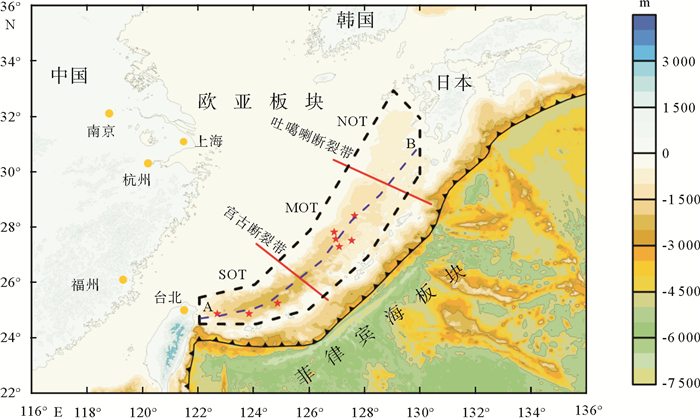
 下载:
下载:
